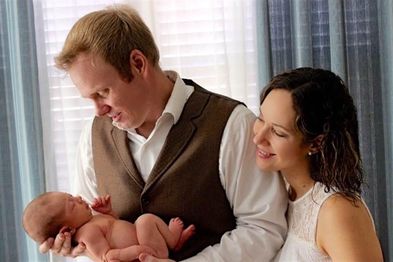 photograph by Brigdet Santiago
photograph by Brigdet Santiago
Infant Vision ... and a little older
Vision is learned just like speech is. You can hear babies learn speech, but you do not know what to watch for as their eyes learn how to see. We have some suggestions to help your baby’s vision. Most have been taken from “Mommy & Daddy You Can Help Me Learn to See” from the American Optometric Association.
Vision is learned just like speech is. You can hear babies learn speech, but you do not know what to watch for as their eyes learn how to see. We have some suggestions to help your baby’s vision. Most have been taken from “Mommy & Daddy You Can Help Me Learn to See” from the American Optometric Association.

1. PROPER NUTRITION DURING PREGNANCY BY AVOIDING ENVIRONMENTAL POISONS LIKE NICOTINE, ALCOHOL, AND SUGAR IS ESSENTIAL.
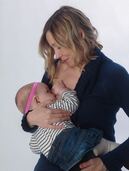
2. BREAST FEED YOUR BABY.
Breast-fed babies are more intelligent and it’s not due to mom’s milk.
When the baby is feeding from mom’s left breast the right arm, right leg, and right ear are against mom’s chest cavity while the right eye is blocked and vice versa from feeding from the right breast. The left arm and left leg are free to move while the right ear is listening to a familiar heart beat and the left eye is open. The baby is developing bilateral integration, an important step in intelligence.

3. IF YOU BOTTLE FEED REMEMBER TO SWITCH ARMS AS IF BREAST FEEDING.
4. MOVE THE CRIB IN VARIOUS POSITIONS IN THE ROOM.
This gives your baby different views of his world important in developing binocular vision and directionality as does the next two suggestions.
This gives your baby different views of his world important in developing binocular vision and directionality as does the next two suggestions.
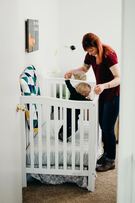
6. TALK TO YOUR BABY FROM DIFFERENT POSITIONS.
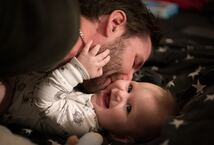
7. TALK IN A NORMAL VOICE, NOT ALWAYS A "BABY" VOICE.
This helps not only with sensory matching but allows your baby to experience differences and similarities important in binocular vision.
This helps not only with sensory matching but allows your baby to experience differences and similarities important in binocular vision.

8.ALLOW YOUR BABY TO HEAR THE DIFFERENCE BETWEEN A MALE AND FEMALE VOICE.
Gentleman, avoid the high squeaky falsetto. Use your normal voice. This helps in the vision processing skill of logic and reasoning with your baby associating the deeper voice with the male image. It also helps with directionality as your baby sees a difference between a male and female voice.
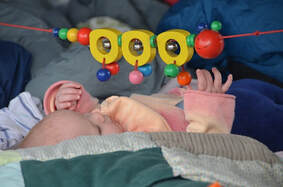
9. PLACE A TACTUAL MOBILE (PLAY GYM) ON THE CRIB THAT CAN BE DISMANTLED.
It is moved to the side when not in use so your baby gets an opportunity to see further out in space. The attractive mobile may keep him centered in close space.
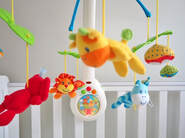
10. MAKE SURE THE T ACTUAL MOBILE ( PLAY GYM ) MAKE SENSE.
You touch knobs, pegs, and balls, but not cows, lions, and elephants. Yet the colors are great here.
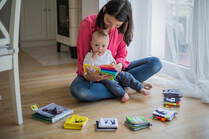
11. ALLOW YOUR BABY IN OTHER ROOMS DURING THE DAY.
Your environment varies from day today, so should your baby’s.

12. CHANGE AND FEED YOUR BABY FROM ALTERNATE SIDES.
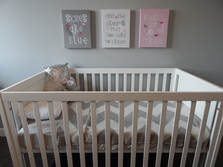
13. CAREFULLY SELECT THE CRIB CONSTRUCTION.
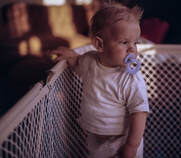
☹ certain meshes are loosely woven enough to prevent your eyes from focusing through them
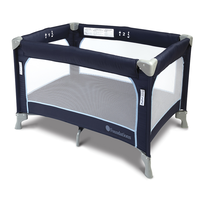
☺ Mosquito type seems the best.
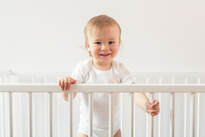
☹ Wooden bars are stylish but afford the baby an opportunity to pull himself up on two legs too early.
They key here is the development of binocular vision by removing opportunities of erecting themselves in the vertical position too early. Binocular vision requires crawling and then creeping before walking. This develops the large muscles of that support the fine eye muscles that align the eyes.
They key here is the development of binocular vision by removing opportunities of erecting themselves in the vertical position too early. Binocular vision requires crawling and then creeping before walking. This develops the large muscles of that support the fine eye muscles that align the eyes.
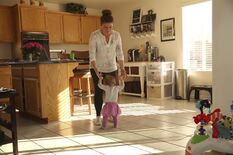
14. DO NOT HOLD YOUR BABY IN A STANDING POSITION EITHER IN YOUR LAP OR ON THE FLOOR.
If you do hold your child by the arms to force walking, you will encourage him to walk too early. Watch the expression on babies faces when this happens - 9/10 times you'll see fear.
If you do hold your child by the arms to force walking, you will encourage him to walk too early. Watch the expression on babies faces when this happens - 9/10 times you'll see fear.
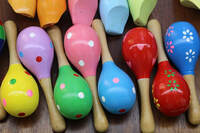
15. A RATTLE DEVELOPS EYE-HAND COORDINATION AND MATCHING OF SENSES.

16. PLAY "PEEK-A-BOO.”
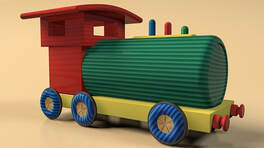
17. ALL TOYS SHOULD BE OF BRIGHT COLOR.
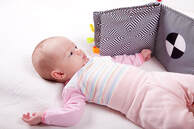
The severe black and white idea of babies’ toys came from research that did not account for how quickly babies acquire color vision. It also ignored the emotional value of color. As an example, red means danger. Besides we live in a world of vibrant colors that enhance enjoyment. Why would we deny such from a baby?
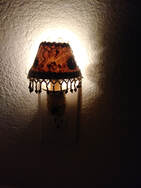
18. DO NOT LEAVE A NIGHT LIGHT ON ALL NIGHT IN YOUR BABY'S ROOM.
It can interfere with natural rhythm. Certainly, use the night light when you must attend your baby at night.
You are taking the first step in learning the principles of spelling that is sequential. This is your baby’s first sequence of day and night. Besides it may help your sleep if the baby awakens to darkness not light and then goes back to sleep.
It can interfere with natural rhythm. Certainly, use the night light when you must attend your baby at night.
You are taking the first step in learning the principles of spelling that is sequential. This is your baby’s first sequence of day and night. Besides it may help your sleep if the baby awakens to darkness not light and then goes back to sleep.
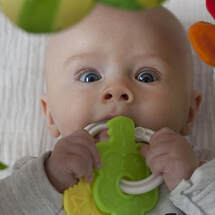
19. ALLOW TOYS TO ENTER THE MOUTH.
He is learning to associate senses, and touch is strong now. ☺ you might even assist your baby in reaching his feet with his mouth.
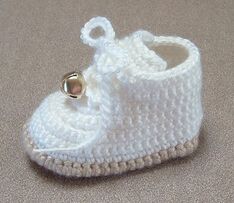
20. BELLS ON BOOTIES ENHANCE SENSE MATCHING.
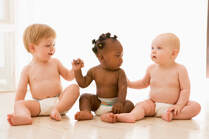
21. ALLOW OTHER CHILDREN TO PLAY WITH YOUR BABY OR AT LEAST HAVE THEM AROUND FOR THE BABY TO OBSERVE AND COPY THEIR BEHAVIOR.
Again, you are developing differences and similarities, one of the building blocks of binocular vision.
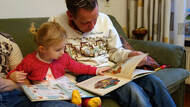
22. READ STORIES TO YOUR BABY.
Yes, read to your baby, not only toddlers. It doesn’t matter if they don’t yet understand the words. You are developing the essential vision processing skill of visualization.
Yes, read to your baby, not only toddlers. It doesn’t matter if they don’t yet understand the words. You are developing the essential vision processing skill of visualization.
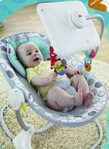
23. AVOID THE FISHER PRICE APPTIVITY DIGITAL SCREENS.
It is difficult to think of anything more damaging to an infant’s vision. It is bad enough for children and adults to spend hours on digital devices, but placing an infant in a car seat with a DVD directly before the baby’s eyes is outrageous.
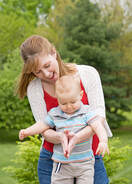
24. PLAY PATTY CAKE AT 16 WEEKS.
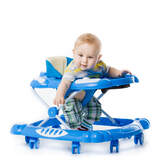
25. AVOID WALKERS! THEY ARE VERY DANGEROUS AND PUT TWO-EYED VISION AT RISK
The danger of careening down stairs or pulling hot pans from the stove should be obvious. The main concern for vision development is making him walk too soon by forcing the vertical position on two wobbly legs. This then interferers with binocular vision development. Canada takes this admonition seriously, and you can be fined heavily for using a walker. Read more as well as what other doctors think about walkers at drhenshaw.net : more, Vision Care Articles, Misc. articles, Walkers and Jolly Jumpers.
The danger of careening down stairs or pulling hot pans from the stove should be obvious. The main concern for vision development is making him walk too soon by forcing the vertical position on two wobbly legs. This then interferers with binocular vision development. Canada takes this admonition seriously, and you can be fined heavily for using a walker. Read more as well as what other doctors think about walkers at drhenshaw.net : more, Vision Care Articles, Misc. articles, Walkers and Jolly Jumpers.
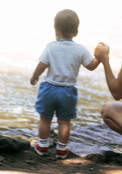
26. WALKING SHOULD BE DONE ON YOUR CHILD’S OWN TIME, IDEALLY AROUND 15 MONTHS, NOT THE RUSHED LESS THAN 12 MONTHS THAT MANY PARENTS PUSH
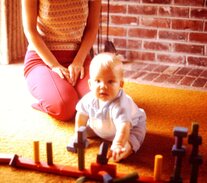
27. HELP YOUR BABY PUT TOGETHER PLASTIC OR WOODEN BLOCKS.
You are developing eye-hand coordination, logic and reasoning, and visualization.
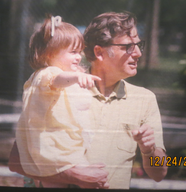
28. PLEASE AND THANK YOU HELPS YOUR CHILD REALIZE VISUAL GRASP AND RELEASE.
This is a basis of concentration and binocular vision. The two skills are dependent on each other and need a rest now and then, hence the release. When you read you must point your eyes at the word, so to speak, grab it. Then to move onto the next word you have to release the word you had just grabbed.
This is a basis of concentration and binocular vision. The two skills are dependent on each other and need a rest now and then, hence the release. When you read you must point your eyes at the word, so to speak, grab it. Then to move onto the next word you have to release the word you had just grabbed.

29. AT 6 OR 7 MONTHS, AS OFTEN AS POSSIBLE, ALLOW PLAY ON THE FLOOR, PREFERABLY WITHOUT A DIAPER. ALLOW HIM TO EXPERIENCE DIFFERENT TEXTURES AND SURFACES. THE RUG WOULD REQUIRE THE DIAPER!
Here you develop sensory matching as well as develop the large muscles that eventually support to fine eye muscles.
Here you develop sensory matching as well as develop the large muscles that eventually support to fine eye muscles.
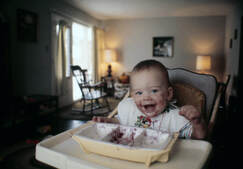
30. ALLOW OBJECTS TO BE PUSHED OFF A HIGH CHAIR.
I think it is obvious this develops depth perception essential not only in sports but thinking.
31. YES, IT IS APPROPRIATE TO PREVENT THE FOOD FROM BEING SHOVED OFF THE HIGH CHAIR WITH WORDS LIKE”NO,” HOLDING ON TO THE PLATE, OR USING SUCTION CUP DEVICES TO SECURE THE FOOD DISH ARE GOOD IDEAS.
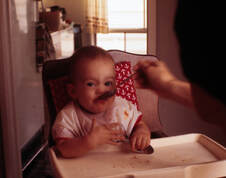
32. USE PROPER WORDS TO DESCRIBE WHAT IS HAPPENING ON THE HIGH CHAIR LIKE, “THERE IT GOES, ALL GONE, HERE IT IS.”
Language is an essential part of vision. Each word we speak must first be visualized. At the same time you are developing logic and reasoning. The next suggestion is based on the same reasoning.
Language is an essential part of vision. Each word we speak must first be visualized. At the same time you are developing logic and reasoning. The next suggestion is based on the same reasoning.
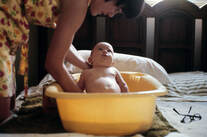
33. USE APPROPRIATE WORDS FOR OTHER ACTIVITIES LIKE BATH, LUNCH, BROTHER, SISTER, ETC.
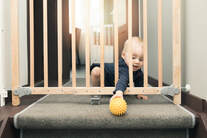
34. DON'T FENCE YOUR BABY IN. THEY NEED TO EXPLORE.
Thus, you need to baby proof. Stairs need a gate. Remember, vision can reach out far beyond the other senses.
35. YARN OR STRING POM POMS ADD TO REGULAR BALLS AND MAY BE EASIER TO HANDLE FIRST.
You are developing eye-hand coordination as well as sensory matching.
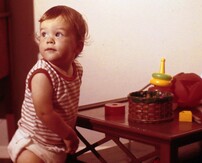
36. ARRANGE A POT AND PAN CUPBOARD WHERE BABY CAN REACH IT IN THE KITCHEN. AN OLD PECULATOR IS GREAT FOR THIS CUPBOARD.
Whoops, there are few or no percolators around. Toys that can easily be taken apart and put back is the goal. The principle is the same for the next suggestion.
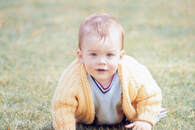
37. WHEN YOUR BABY NEARS A YEAR, HE NEEDS TIME TO WRIGGLE, ROLL, CRAWL, AND CREEP.
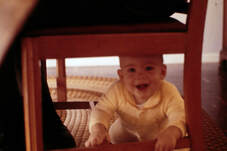
38. WHEN YOUR CHILD GETS STUCK UNDER A DESK OR IN A CORNER SHOW YOUR CHILD HOW TO GET OUT.
☹ Don't simply extract him. Also, allow him to do of much of it as possible by himself. You do not want to develop a dependency relation. Dependencies interfere with the development of vision. Your baby is also developing both boundaries and directionality as well as depth perception.
☹ Don't simply extract him. Also, allow him to do of much of it as possible by himself. You do not want to develop a dependency relation. Dependencies interfere with the development of vision. Your baby is also developing both boundaries and directionality as well as depth perception.
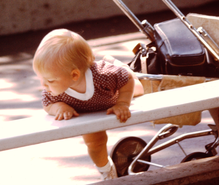
39. ALLOW SUPERVISED PLAY ON STEPS TO EXPERIENCE UP AND DOWN.
He certainly needs protection from severe falls, but little bumps help the learning process.
For PDF Version Click Below
| infant_vision_combinepdf.pdf | |
| File Size: | 168 kb |
| File Type: | |

